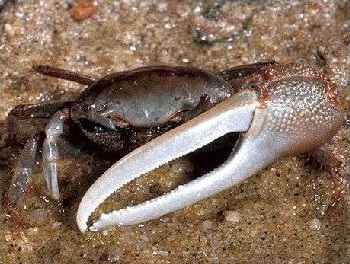Characterization of the Ashepoo-Combahee-Edisto (ACE) Basin, South Carolina
Decapod Crustaceans

Decapod crustaceans are known to play a critical role in metabolizing and controlling the flow of energy in estuarine ecosystems. Decapods are preyed upon by a variety of predators and are also important predators themselves, consuming phytoplankton, benthic algae, and macrobenthos (Coull and Bell 1983). Depending on its intensity, predation is a factor in controlling population density, as well as structuring species assemblages within a habitat. Decapod particulate feeders consume detritus derived from smooth cordgrass and feces, thereby making detritus available to several different trophic levels and processing particles in such a way that substrate is enhanced for accelerated growth by diatoms and bacteria (Field 1983). Decapod crustaceans in the ACE Basin study area occupy subtidal and intertidal estuarine habitats where they are provided a refuge from predation and a source of food. These habitats are exploited by year-round residents, such as grass shrimp, or seasonally abundant species such as blue crab and the penaeid shrimps (Kneib 1984; Weinstein 1979).
Although decapod species are conspicuous inhabitants of the ACE Basin study area and many are economically important, few comprehensive studies of the decapod community have been done in that region. Information is available on the decapod community from shallow marsh, oyster reefs, impoundments and tidal freshwater areas for other coastal areas of South Carolina. Most of the information on decapod species assemblages has come from trawl surveys of the rivers in and near the ACE Basin study area. The trawl surveys (1973-1975) collected a total of 38 species from eight stations in the North Edisto River, and 30 species from four stations in the South Edisto (Wenner et al. 1991). A more recent survey (1993-1999) in the ACE Basin collected a total of 43,319 individuals representing 28 species during the first five years. A greater number of species (26) was collected in the South Edisto, while 23 species were collected from the Ashepoo River and 17 from the Combahee River. This difference probably reflects influence of the strong salinity gradient in the South Edisto, which encourages invasion by stenohaline marine species from the coastal zone. The white shrimp, the brown shrimp, and blue crab were the most abundant species in all three rivers. Because these species utilize the estuaries for only a portion of their life cycle, distinct seasonal changes in abundance of these dominant species occurred in the study area.
Given the baseline information collected on decapod crustaceans from the ACE Basin study area, it appears that this system is similar to others that have been studied throughout the state. This system supports a diverse assemblage of decapods, and provides seasonal habitats for transient species and permanent year-round habitats for resident species. Given differences in life history, sizes, and behaviors of decapod crustaceans, further efforts to understand their community structure in the ACE Basin study area should focus on shallow marsh and freshwater areas where there is a paucity of information.
